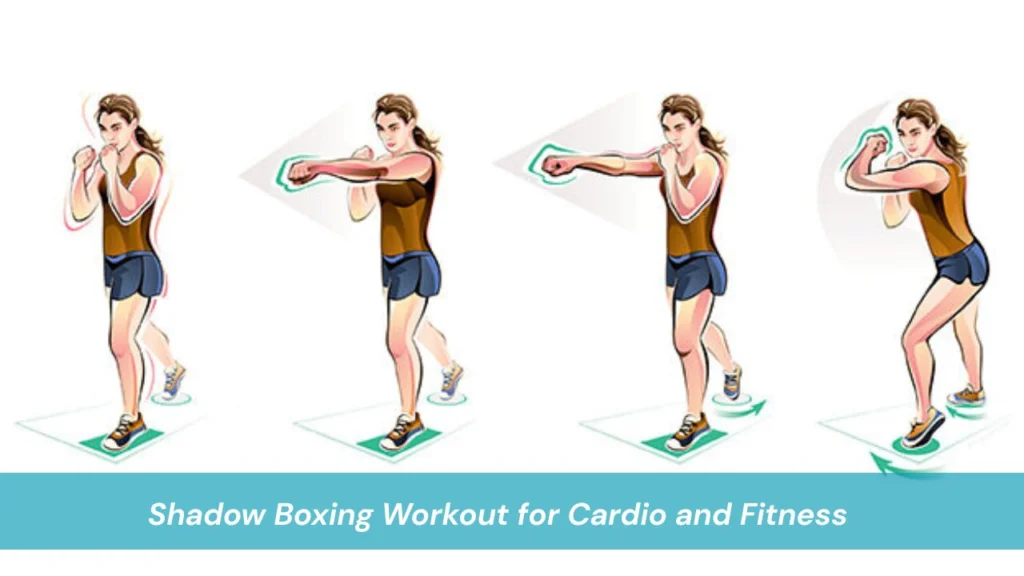Shadow boxing workouts are one of the most effective and versatile training methods for anyone interested in fitness, boxing, or martial arts. This workout requires no equipment, very little space, and can be done by people of all fitness levels from absolute beginners to professional fighters. Shadow boxing is not just about throwing punches in the air; it’s a strategic, full-body workout that improves endurance, strength, balance, and coordination while sharpening fighting techniques.
In this comprehensive guide, we’ll break down what shadow boxing workouts are, why they are effective, how you can incorporate them into your training routine, and common mistakes to avoid. By the end, you’ll know exactly how to structure a complete shadow boxing routine that helps you burn calories, improve agility, and master technique.
Key Takeaways
- Shadow boxing workouts improve cardiovascular endurance, coordination, balance, and overall fitness without requiring equipment or a gym.
- This training method helps build proper boxing technique, footwork, and muscle memory through focused movement and visualization.
- Shadow boxing is suitable for all fitness levels, from beginners learning basics to professionals refining fight strategies.
- Consistent shadow boxing supports weight loss, stress relief, and full-body conditioning when done with correct form and intensity.
What Is Shadow Boxing?
Shadow boxing is the practice of moving and throwing punches in the air as if sparring with an invisible opponent. Unlike bag work or pad work, shadow boxing focuses on technique, rhythm, footwork, and visualization. Fighters often use shadow boxing as a warm-up before hitting the heavy bag, sparring, or training in the ring.
Even though it looks simple, shadow boxing requires mental focus and physical engagement. You must imagine an opponent, plan movements, and throw combinations with proper form, making it an excellent workout for both the body and the mind.
Benefits of Shadow Boxing Workouts
Shadow boxing may look like a basic exercise, but its benefits extend beyond physical conditioning. Here’s why this workout is a must for anyone serious about fitness or combat sports.
First, shadow boxing enhances cardiovascular endurance. Since it involves continuous movement, footwork, slips, ducks, and combinations it keeps your heart rate elevated, promoting calorie burn and improving stamina. Many athletes use shadow boxing as a form of high-intensity cardio that complements other training.
Second, shadow boxing sharpens technique and coordination. By practicing punches, slips, and counters repeatedly, you build muscle memory, which helps in real fights or sparring sessions. Beginners can use it to learn proper stance and striking mechanics, while professionals refine advanced combinations.
Third, it improves balance and footwork. Boxing is not just about throwing punches it’s also about controlling space and movement. Shadow boxing teaches you to stay light on your feet, pivot effectively, and maintain balance while striking or defending.
Fourth, shadow boxing is a stress reliever. Visualizing an opponent and throwing punches can release tension, improve mood, and provide mental clarity. It’s a form of moving meditation that helps athletes enter “the zone.”
Lastly, shadow boxing is accessible. No equipment, no gym, and no partner are needed. Whether you’re in your bedroom, hotel room, or outdoors, shadow boxing can be practiced anytime.
How to Do Shadow Boxing Workouts Correctly
For maximum effectiveness, shadow boxing should be approached with focus rather than random movement. Start with a proper stance feet shoulder-width apart, knees slightly bent, chin tucked, and hands up to guard your face.
Begin slowly, practicing basic punches such as the jab, cross, hook, and uppercut. Combine these with defensive movements like slipping, weaving, and blocking. As you progress, incorporate footwork by stepping forward, backward, and sideways to simulate ring movement.
The key is visualization. Imagine a real opponent in front of you. Picture their punches and respond with counters, slips, and combinations. This mental rehearsal improves fight IQ and prepares you for real sparring situations.
Control is crucial. Avoid flailing your arms or overextending punches. Keep movements sharp, precise, and realistic. Your goal is to train the body and mind, not just to sweat.
A Complete Shadow Boxing Workout Routine
Here’s a sample 20-minute shadow boxing workout you can follow:
- Warm-up (3 minutes): Light footwork, arm swings, and jab-cross combinations to loosen muscles.
- Round 1 (3 minutes): Focus on basic punches, jab, cross, hook, and uppercut. Practice slow and controlled form.
- Round 2 (3 minutes): Add defensive moves such as slips, ducks, and parries. Visualize avoiding punches.
- Round 3 (3 minutes): Work on combinations jab-cross-hook, uppercut-hook-cross. Move around the room as if in the ring.
- Round 4 (3 minutes): Increase intensity with faster punches and footwork. Add pivots and angles.
- Round 5 (3 minutes): Freestyle shadow boxing. Mix offense and defense, imagining a live opponent.
- Cool-down (2 minutes): Light footwork, relaxed punches, and deep breathing.
This routine can be adjusted for beginners by reducing round times to 1–2 minutes or intensified for advanced boxers by extending rounds and increasing speed.
Advanced Shadow Boxing Techniques
Once you master the basics, you can push shadow boxing further with advanced methods.
One way is to add resistance. Use light dumbbells or resistance bands to increase arm and shoulder endurance. Be careful not to compromise to keep movements smooth and controlled.
Another technique is to shadow a box in front of a mirror. This allows you to check posture, punch mechanics, and defensive movements in real-time. Many professional fighters use mirrors to self-correct.
Adding footwork drills is also powerful. Practice circling, side-steps, and pivots while throwing punches. This makes your shadow boxing feel more like a real fight scenario.
For a mental challenge, integrate visualization exercises. Imagine specific opponents, their styles, and their attacks. For example, if you’re preparing for a taller opponent, visualize slipping under jabs and countering with hooks to the body.
Common Mistakes in Shadow Boxing Workouts
Despite its simplicity, many people make mistakes during shadow boxing that limit progress.
The first mistake is treating it like a random movement exercise. Shadow boxing should have intention and focus, not just wild punches.
The second mistake is neglecting defense. Beginners often throw punches without practicing slips, blocks, or head movement. Real boxing requires both offense and defense.
Another common error is poor footwork. Standing flat-footed or crossing your legs while moving reduces balance and effectiveness. Always stay light on your toes and maintain proper stance.
Overextending punches is also problematic. Reaching too far can strain shoulders and teach bad habits. Punch within range, as if striking a real opponent.
Lastly, people often underestimate intensity. Shadow boxing should mimic fight conditions using speed, rhythm, and strategy instead of going through the motions.
Shadow Boxing for Weight Loss and Fitness
Shadow boxing isn’t only for fighters it’s also a powerful workout for general fitness and weight loss. A 30-minute session can burn anywhere from 300 to 500 calories depending on intensity. The constant movement, rapid punches, and footwork engage multiple muscle groups, turning it into a high-intensity interval workout.
In addition to calorie burn, shadow boxing tones the shoulders, arms, chest, and core. Since it involves twisting and rotating, it strengthens oblique muscles and improves overall athletic conditioning.
For fitness enthusiasts, combining shadow boxing with bodyweight exercises like push-ups, squats, or burpees creates a full-body workout that builds strength and endurance simultaneously.
Shadow Boxing for Beginners vs. Professionals
Beginners should focus on learning correct stance, balance, and punch mechanics. Their sessions should be slower, controlled, and centered around building good habits. Using a mirror can help them develop proper form early.
Professional fighters, on the other hand, use shadow boxing to rehearse fight strategies, work on speed, and refine defense. For them, shadow boxing is as much mental as physical; it prepares them for the rhythm of actual fights.
This versatility makes shadow boxing unique: it adapts to all levels, from first-time exercisers to world-class boxers.
FAQs
How long should I shadow box each day?
Beginners can start with 10–15 minutes, while advanced practitioners can go for 20–30 minutes. Consistency matters more than duration.
Do I need equipment for shadow boxing?
No equipment is required, though a mirror helps with form and light weights can be added for resistance.
Can shadow boxing help with weight loss?
Yes, shadow boxing is a high-intensity cardio workout that can burn calories effectively and support weight loss goals.
How do I make shadow boxing more challenging?
Increase speed, add resistance with light weights, or incorporate advanced footwork drills to push intensity.
Is shadow boxing safe for beginners?
Absolutely. As long as you maintain proper form and avoid overextending punches, it’s safe and effective for beginners.
Conclusion
Shadow boxing workouts are one of the most powerful yet underrated forms of training in boxing and general fitness. They sharpen your technique, improve coordination, and provide a full-body workout that burns calories and builds endurance. Whether you’re aiming to become a better fighter or simply get fit at home, shadow boxing offers a flexible, equipment-free solution.
The best part is that shadow boxing is accessible to everyone. You can start slowly, focus on fundamentals, and gradually progress to advanced variations. When practiced with intention, visualization, and consistency, shadow boxing becomes more than a workout it becomes a skill-building, confidence-boosting practice that benefits your body and mind.
So, lace up your imaginary gloves, visualize your opponent, and step into the ring of your mind. With discipline and focus, shadow boxing can transform your fitness journey and elevate your fighting skills to the next level.




